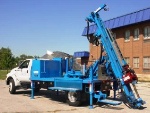
Case Study: Sonic Drills and Insitu Treatment Save Ohio DOT $250,000
ARS Technologies injects an oxidant and catalyst to speed bioremediation in a large-scale groundwater cleanup project.
Using advanced sonic drilling equipment and in-situ chemical oxidation and bioremediation treatments, ARS Technologies, Inc., of New Brunswick, N.J., reduced the cost of a five-acre groundwater and soil cleanup in Newark, Ohio from $1.43 million to $1.17 million, a saving of 18 percent for the Ohio Department of Transportation (ODOT).
“This type and size groundwater treatment project is an ideal application for our large-scale chemical batch and injection processing equipment,” said Robert Kelley, Ph.D., ARS’ vice president for technology development.
The contaminated site, currently a grass-covered vacant lot, was occupied from 1947 to 1987 by an asphalt testing laboratory and other office, garage, vehicle maintenance, and storage buildings belonging to ODOT, which commissioned the cleanup. A variety of chlorinated organic contaminants found their way into the soil and groundwater over that period, including solvents and degreasing agents and laboratory wastes associated with asphalt testing, primarily 1,1,1-trichloroethane (1,1,1-TCA) and trichloroethylene (TCE). Both compounds are classed as probable carcinogens and mutagens with a wide range of adverse health effects.
After ODOT closed the facility in 1987, the buildings were removed, the most severely contaminated soil was excavated, and a pump-and-treat remediation facility installed on the site. However, recent groundwater monitoring still showed TCE concentrations of 200 parts per billion (ppb), or about 40 times the maximum allowed by the federal Safe Drinking Water Act.
In 2009, ODOT retained Hull & Associates, Inc. of Toledo, Ohio, to prepare a plan to clean up the groundwater to the Ohio EPA drinking water standard of less than 5 ppb, using chemical injection of remedial materials to neutralize underground contamination in a target zone extending from 17 to 30 feet below the ground surface.
ARS applied a combined treatment to the subsurface consisting of an oxidant, Klozur® sodium persulfate, activated with PermeOx Plus®, a time-release calcium peroxide-based catalyst designed to accelerate the aerobic bioremediation of hydrocarbons. According to FMC Chemical Company, which developed the technology, this is one of the largest PermeOx/Klozur applications to date in the United States.
“The project required more than 900 injection points and over 150,000 gallons of amendment solution in the source area and across a dissolved plume that extended under several adjacent properties,” Kelley said. “But with two newly acquired EP-Sonic high-speed compact drill rigs and a GeoProbe unit for injection, we were able to complete the project safely and effectively within the scheduled period of 45 working days, averaging 15 holes per day.”
“At this point the project looks very successful,” Kelley noted. “The oxidant was properly activated, and we have very complete contact and connectivity throughout the formation. Now we wait for the chemicals to work and to review post-treatment groundwater analytical samples over the next six-month period.”
Based upon the results of the post-treatment, some additional limited spot treatment injections may be required.
Source: ARS Technologies